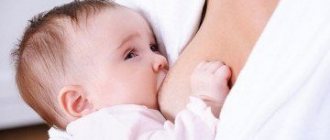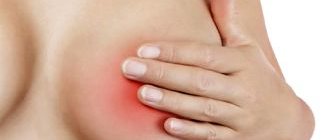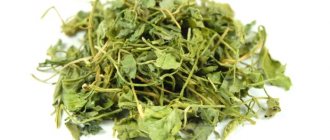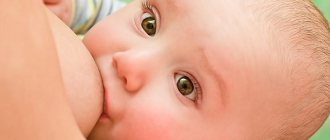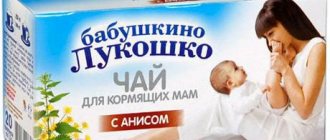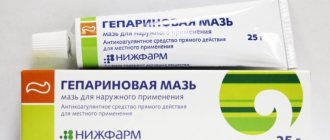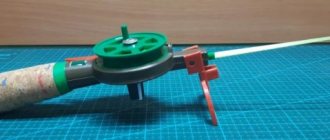What do cracks look like?
If the integrity of the nipple is violated, the woman experiences sharp pain radiating to the shoulder blades during breastfeeding . In addition to pain, the mother may experience itching, tingling, redness and hyperthermia in the breast area. Without proper treatment, the damaged areas are likely to become infected and develop candidiasis or mastitis.
The crack can extend deep into the nipple for a considerable distance. In the absence of therapy, the edges of the wound become denser, the vessels are compressed, and the elements of the lymphatic system become vulnerable to infections. From the outside, the wound looks like a “split” running from the center of the nipple to the side.
Breast cracks in the early stages of introducing breastfeeding are normal and disappear after a few days. But sometimes this does not happen for a number of reasons.
Reasons for appearance
Lactation is a process provided by nature. But even this must be treated with due responsibility, avoiding gross mistakes. Among which:
- lack of knowledge about the physiology of the milk production process;
- incorrect latching technique;
- improper breast care and hygiene.
Cracks in the nipples during feeding also form due to weakened immunity, anatomical features of the breast structure and hypovitaminosis in nursing mothers.
Incorrect chest grip
Incorrect mouth girth around the chest is the most common cause of cracks. Normally, the nipple should fit snugly against the baby's palate while the baby's gums squeeze the areola. If this technique of attachment is violated, the child squeezes the very tip of the breast with his mouth, causing damage to it. Even limiting the feeding time will not help to avoid pain and the growth of the crack in size.
At a later age, the child may cause damage to the chest at the time of teething. Then the mother often has a crack around the nipple .
Violation of feeding technique
The second most popular cause of cracks is considered to be abrupt and inaccurate removal of the child from the breast. Such damage can be caused when the baby's nipple is suddenly taken away, in which he clenches his gums and pulls it back. It would be more correct to fix the slightly open jaws with your little finger and carefully remove the breast from the baby’s mouth.
It is also important at the time of feeding to hold infants with their stomach towards the mother, supporting the head, otherwise, after saturation, the baby will turn in the opposite direction, holding the nipple in the gums.
Sometimes the formation of wounds is also influenced by how long the baby sucks at the mother’s breast.
Incorrect pumping
Due to lack of knowledge, many women express their breasts incorrectly. At the same time, they compress the nipple itself instead of the areola. Therefore, the best solution before expressing would be to consult a breastfeeding specialist.
Some modern breast pumps can also cause injury to a woman when the nipple is latched on. This happens as a result of the roughness of the material of the device or non-compliance with the instructions for its operation.
Breast skin care
Not only rare, but also frequent washing of the nipples (after each feeding) harms their integrity. Water removes the natural lubricant secreted by the Montgomery gland from the skin. This substance has moisturizing, antiseptic and protective properties.
A nursing mother should:
- forget about skin-drying medications;
- give your breasts air baths more often and stop regularly wearing absorbent nipple pads.
Sensitive nipples
Breast damage from breastfeeding also occurs due to nipple sensitivity (60% of cases) - this condition is called mastodynia. In addition to cracks, with high breast sensitivity, a woman experiences swelling and discomfort in the mammary glands .
Mastodynia is associated with physiological processes (growth of mammary glands in adolescence, during pregnancy or in the premenstrual period). This phenomenon may also be associated with diseases (mastitis, abscess, mastopathy) or mental disorders of the woman.
Nipple skin diseases
Women with too dry skin rarely try to maintain natural feeding, since their nipples almost always have cracks. The main cause of this symptom may be eczema (atopic dermatitis).
Application of nipple
When breastfeeding and using a pacifier at the same time, the baby will not adapt to new conditions every time, so over time he will develop a uniform sucking technique, which can harm the breast. The baby quickly stops opening his mouth completely during feeding and adapts to pressing on the nipple with his jaws, rather than with his tongue.
Why do cracked nipples appear during breastfeeding?
I must say that in the first days of feeding, almost all young mothers complain of pain. It’s just that the skin of the nipples has not experienced such a strong impact before and pain receptors thus signal a sharply increased load. Usually within a week the discomfort decreases, the skin gradually “hardens” and painful sensations completely cease to bother nursing mothers. However, sometimes the situation is different: cracks appear on the nipples and feeding turns into a painful process.
The main reason for the appearance of cracked nipples during breastfeeding is dry skin. This is facilitated by: frequent washing of the breasts with soap, although not so long ago it was believed that they should be washed before each feeding, and treating the nipples with antiseptic solutions. Dry skin can also be caused by hypovitaminosis, in particular a lack of vitamins A, B, and C. On the other hand, constant contact of the nipples with moisture, for example during the continuous release of milk, also contributes to the appearance of cracks.
Often cracked nipples appear due to improper attachment of the baby to the breast. The baby should not grasp the nipple, but the entire areola. When fully latched, the baby squeezes out the milk by pressing the milk sinuses with his gums, while the nipple is in his mouth and is not injured.
The appearance of cracks in the nipples during breastfeeding is also largely contributed to by the newborn’s temperament. According to statistics, women whose babies actively suckle milk have abrasions much more often than mothers who quietly suckle their babies.
How to treat cracked nipples: medications and traditional medicine
How to cure cracks? After damage appears, a woman needs to get rid of the causes of its occurrence as soon as possible. Only then can you begin to treat the diseased area.
But when choosing an ointment, cream or gel, it is important to focus on the recommendations of a guards specialist. Only he can tell you what to do in this situation, and how to quickly cure cracks in the nipples of a nursing mother.
Ointments with dexpanthenol
Dexpanthenol stimulates epithelial cell division, promoting rapid healing of cracks.
Among the best-selling ointments with this substance are:
- Dexpanthenol. Light yellow ointment for cracked nipples is used for external use and has a regenerating and antiseptic effect. D-panthenol perfectly eliminates the problem and does not have an unpleasant odor. The cost of the product is approximately 150 rubles.
- Bepanten. This product has a pronounced regenerating effect. The concentration of dexpanthenol (5%) in the ointment is safe for nursing mothers and their children. The cost of Bepanten is about 400 rubles. As analog products, you can try D-panthenol or Elfa cream.
- Pantoderm. This ointment, produced in Russia, has healing, analgesic and anti-inflammatory properties. Finding this drug in pharmacies is more difficult than others. The cost of Pantoderm is from 200 rubles.
Ointments with zinc oxide
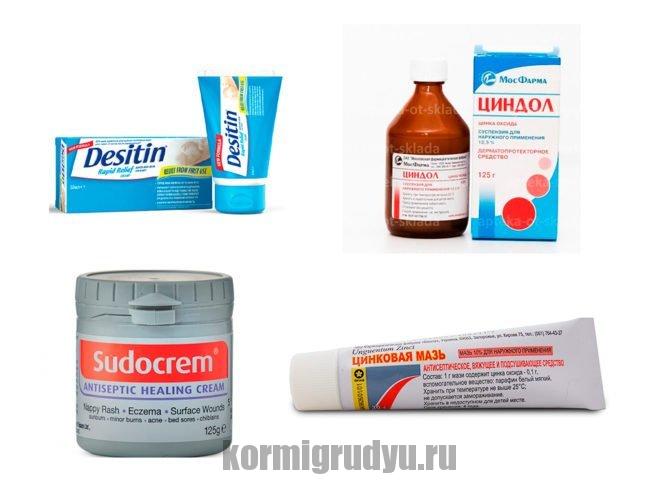
Due to the toxicity of zinc oxide, preparations containing it are not recommended for use for healing cracks. Ointments with this component have a healing and drying effect.
Doctors most often prescribe the following drugs to women:
- Desitin. The product has a specific odor due to the presence of cod liver oil in it. One pack of this healing drug will cost about 250 rubles.
- Sudocrem. This remedy is suitable for mother and child (for the treatment of diaper dermatitis), and will cost about 350 rubles.
- Zinc ointment. The most budget option for regenerating ointment costs approximately 30 rubles.
- Tsindol. A disinfectant similar in properties to zinc ointment, but different in price (80 rubles).
Creams with lanolin
These creams are more likely to prevent cracked nipples. They seem to create a protective film that protects the skin from damage, promotes wound healing and moisturizes dry areas. The most famous remedies with this substance:
- Purelan (Medela). This is an antiseptic cream for cracked nipples to prevent their further occurrence. The cost of such a product is from 250 rubles.
- Lanolin. This is animal fat obtained by boiling sheep's wool. The price of such a cream starts at 500 rubles.
- Lanovit. A soothing remedy for sensitive nipples, allowing you to heal cracks and make breastfeeding easier. Cost - from 500 rubles.
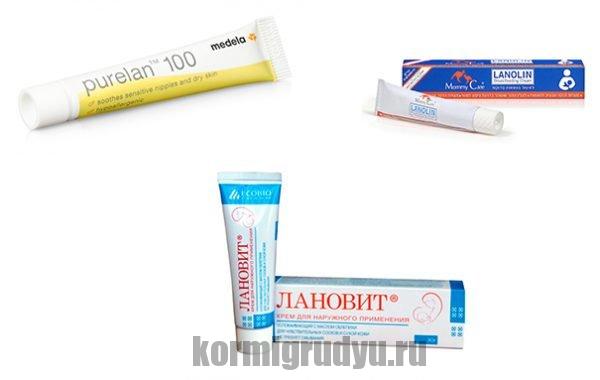
- Pigeon nipple cream. The product has an analgesic, healing and protective effect. Price - from 550 rubles.
- Babyline breast skin cream. This breast cream protects the skin from cracking and gently moisturizes it. This product costs around 300 rubles.
- AVENT Soothing Nipple Cream. Perfect for preparing your breasts for breastfeeding. Price - about 800 rubles.
- Sanosan nipple balm. With this product, cracks heal in a matter of days. And it costs about 350 rubles.
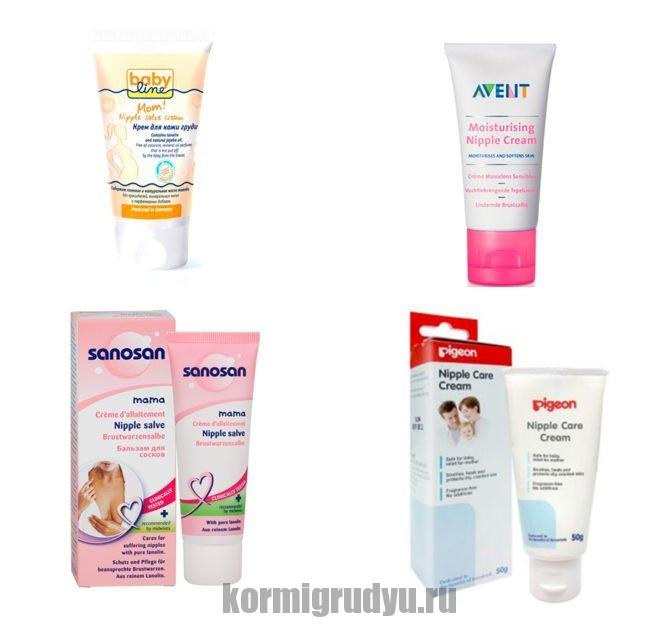
Preparations with retinol
Retinol is vitamin A, which promotes the rapid restoration of damaged tissues. It moisturizes the skin and is great for cracked breasts. The most famous products include:
- We see. The oil-based drug perfectly heals wounds, and costs about 100 rubles.
- Radevit asset. Nourishes and softens damaged areas of the skin, gradually removing cracks. The cost of the product is about 500 rubles.
- Retinol palmitate. The drug heals damaged areas of the skin without staining clothes, and has a low cost (from 100 rubles).
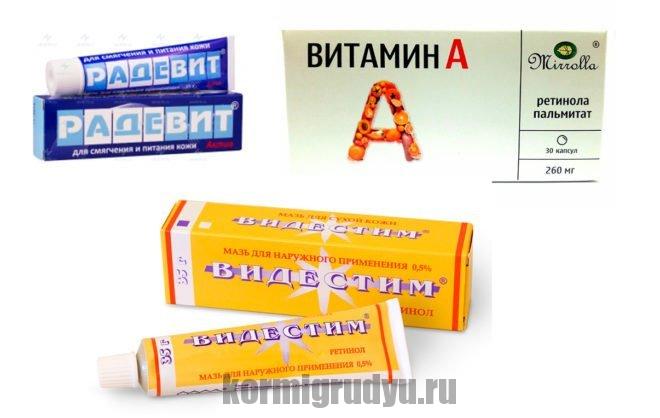
Regeneration stimulants
These drugs are based on regeneration stimulants obtained from animal blood. With them, even the deepest cracks can heal much faster. The following are very popular:
- Solcoseryl gel. The product is available in the form of ointments or gels. Solcoseryl is quickly absorbed into the skin and starts its regeneration processes. The ointment requires a thicker layer, but is considered more effective than the gel. Solcoseryl does not penetrate into the blood and does not spoil the quality of milk. The cost of the drug is about 300 rubles.
- Actovegin gel. The drug activates tissue metabolism and stimulates the regeneration process. Price - from 400 rubles.
- Deoxynate. The product activates cellular and humoral immunity, healing damaged nipple tissue. Sold in ampoules, costing from 3 thousand rubles for 10 pieces.
- Methyluracil. A budget product (from 40 rubles) accelerates cellular regeneration processes and has an anti-inflammatory effect.
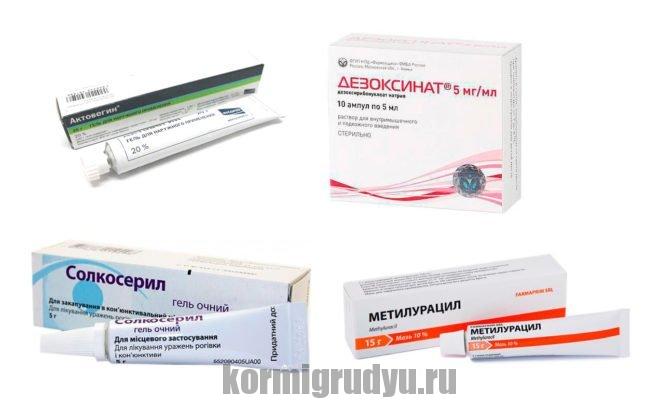
Natural oils
Natural oil promotes not only the healing of damaged areas of the breast, but also improves the condition of the skin. It softens, moisturizes and smoothes it.
Sea buckthorn oil is not just a medicinal, but also a prophylactic agent. For the fastest effect, it should be applied to the skin after each feeding.
Many mothers say the fastest results come from peach oil. It is often used in cases where panthenol-based products do not help. Wound healing will begin the very next day after application.
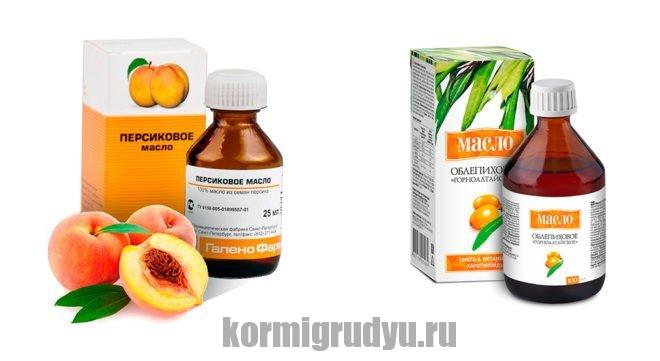
Balm Karavaev Vitaon is a mixture of 12 extracts of medicinal plants. It is used to treat damaged nipples or mastitis.
Traditional methods

In the process of treating cracked nipples during breastfeeding, traditional medicine recipes are often used. Why them? Because they are time-tested:
- Breast milk. For minor damage to the nipple, only a few drops of squeezed out and dried milk will be enough.
- Olive oil. This oil should be applied on a regular basis, then nipple cracks will not grow and form again.
- Cedar oil. It has properties similar to sea buckthorn oil. It is a source of vitamin E and B vitamins. You need to lubricate your nipples with it immediately after feeding.
- Aloe vera juice. Place a few drops of plant juice on the damaged nipple, then cover it with gauze and add a little more healing agent. The compress should be changed as it dries.
- Calendula. After feeding, you need to lubricate the damaged area with calendula ointment and let the breasts “breathe” for 15-20 minutes.
- Cabbage leaf. A fresh cabbage leaf placed in a bra cup cools the skin, relieves pain and kills pathogenic microflora. During the day, you will only need to dry your breasts after each feeding.
Before using folk remedies, you should consult with a breastfeeding specialist.
How women deal with cracked nipples
Judging by the reviews from the forums, cracks in the nipples mainly bother nursing mothers, and they cause them very serious inconvenience. More experienced people advise smearing the breasts with special creams, for example, D-panthenol or Bepaten. Avent oil also helps, and it copes with any cracks. Another good remedy is rest - do not give the baby a sore breast for a couple of days, but simply express milk. The breasts will rest and the cracks will heal.
Also, experienced mothers note that sometimes cracks appear out of habit. Gradually, the nipple gets used to being grasped by the child, and the cracks disappear.
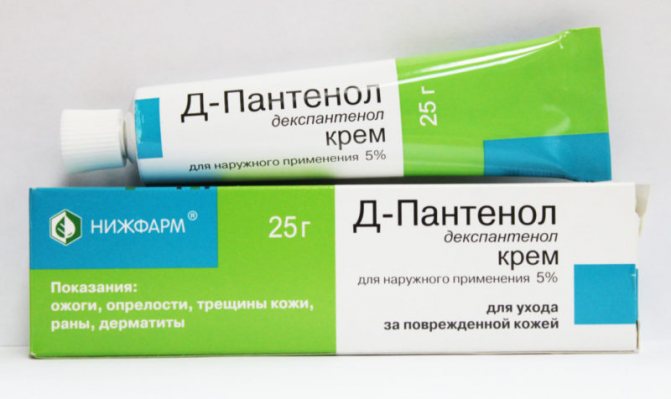
Contraindications to treatment: what not to do
Healing cracks takes time. Many women stop breastfeeding because they have no idea how to feed a child with this unpleasant problem. In order not to worsen the situation, you should adhere to the following rules:
- Do not wash your breasts with soap. An alkaline environment damages the skin even more, and nipple cracks can become even deeper and wider.
- You should not take antibiotics or smear your breasts with products based on them without a doctor’s prescription.
- There is no need to lubricate the nipples with brilliant green or iodine. These drugs dry out the skin and erode it even more.
- Do not try to wipe or apply swabs soaked in alcohol to your nipples. Such actions may result in a chemical burn.
- You should always monitor the moisture in the nipple area and change breast pads more often.
Improper breast care is worse than no treatment. They can not only aggravate the situation, but also lead to the development of more serious diseases.
Prevention of cracks
Is it possible to prevent breast lesions? All rules for preventing the development of cracks are based on the correct placement of the baby to the breast and compliance with nipple care measures:
- Even during pregnancy, you need to start caring for the skin of your nipples (daily breast washing followed by massage using oil). It is better to completely eliminate soap and use warm water for washing.
- Avoid hypothermia or overheating of the chest.
- It is advisable to choose a bra that is suitable in size and made from natural materials.
- Inflammatory and infectious diseases cannot be ignored; they must be treated completely and on time.
- You should be regularly examined by a gynecologist and mammologist.
- The chest must be protected from sunlight.
- Feeding should not take more than 40 minutes. After the process is completed, you need to try to carefully remove the nipple from the baby’s mouth.
- If there is an excess of milk, you need to regularly pump, otherwise the treatment of cracked nipples may be complicated by the appearance of lactostasis.
How to treat a nipple that has several shallow cracks?
No matter how strange it may sound, the first remedy for cracked nipples is your own dairy product. After your baby has eaten, carefully express a few drops and let them dry directly on your chest. Due to its antiseptic properties, breast milk is the best prevention of inflammation of the delicate skin.
In addition, every young mother should have a lanolin-based product in her medicine cabinet. It can be included in creams and ointments, or sold in its pure form. The consistency of lanolin is quite dense, which allows it to cover the skin with an imperceptible thin film and promotes its speedy healing. If you use pure lanolin (which is preferable until the wound has become infected), then you do not have to wash it off before feeding - it is a natural substance.
We also recommend viewing: Rules for using pills for breast enlargement
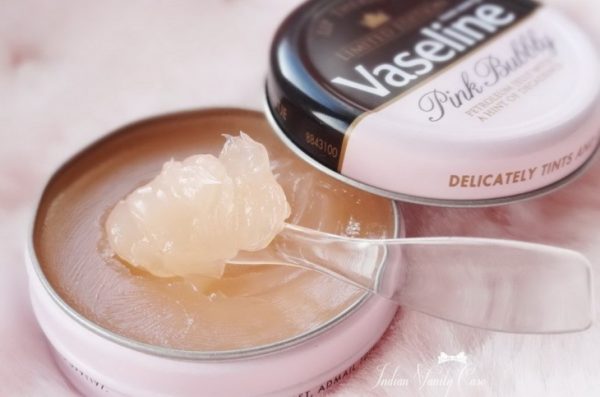
For those who are interested in how to get rid of cracked nipples using traditional methods, there is another proven recipe: mix Vaseline and rosehip oil in a ratio of 2 to 1. After the next feeding, apply the viscous mixture to the damaged skin and place a napkin. The top of the chest can be covered with cling film or polyethylene. Then put on a bra or just throw on a towel. You need to keep the product on the nipple until the baby asks for the breast again. Then rinse everything off with warm water, gently pat dry with a soft cloth and start feeding.
If you do not start the problem and take action as soon as you feel painful discomfort, then after 2-3 days the feeding process will cause you only positive emotions.
